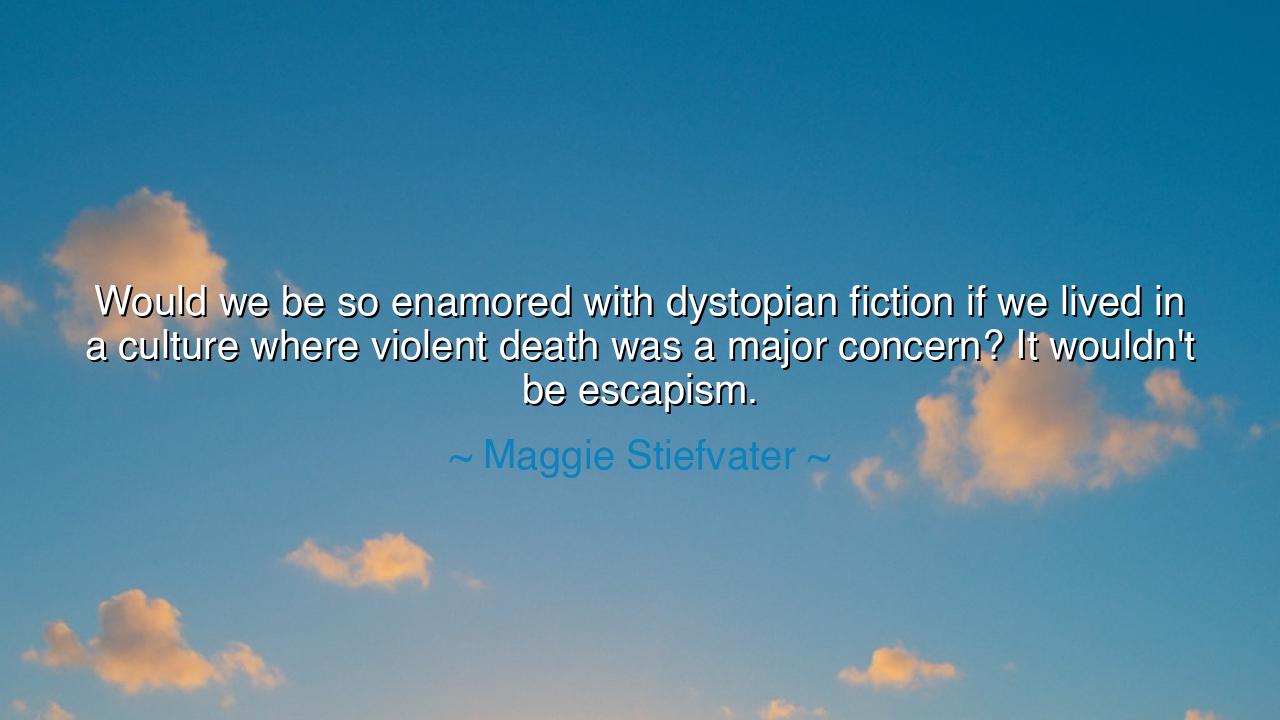
Would we be so enamored with dystopian fiction if we lived in a
Would we be so enamored with dystopian fiction if we lived in a culture where violent death was a major concern? It wouldn't be escapism.






The words of Maggie Stiefvater — “Would we be so enamored with dystopian fiction if we lived in a culture where violent death was a major concern? It wouldn’t be escapism.” — ring with quiet wisdom, reminding us of how imagination is shaped by comfort, and how art changes when survival is no longer at stake. Beneath these words lies a truth both subtle and profound: that our fascination with darkness often arises only when we are safe from it. Those who live with peace can afford to imagine catastrophe; those who dwell amid fear long instead for peace. Thus, Stiefvater’s question is not about fiction alone, but about the heart of civilization itself — about what it means to live in an age removed from the immediacy of suffering, yet drawn to it in our dreams.
Maggie Stiefvater, a contemporary American author known for her lyrical tales of myth and modernity, spoke these words in reflection on the surge of dystopian literature — stories of ruined worlds, tyrannical governments, and human despair. She recognized that readers of the modern age, especially those in prosperous nations, consume these tales not as tragedy but as escapism, a thrilling simulation of danger. To imagine desolation is, paradoxically, a form of luxury. In ages past, when famine, plague, and war walked openly among men, the people did not read of dystopias — they lived within them. Then, art turned instead toward the ideal, the divine, the hope of heaven or rebirth. Stiefvater thus calls us to reflect: our taste for imaginary ruin reveals our distance from real peril.
When she says, “It wouldn’t be escapism,” she speaks of the transformation of art when fear becomes real. The man who lives in the shadow of violence does not read of war for pleasure; the woman who has seen tyranny does not find joy in imagining it again. To those who live with safety, fictional darkness offers intensity without consequence — a way to feel fear without being touched by it. But to those who live amid blood and hunger, darkness is not art but reality, and the imagination seeks instead the light. The luxury of fear belongs to the privileged, for only the comfortable can play at suffering.
History itself bears witness to this cycle. During the Great Depression of the 1930s, when bread was scarce and despair filled the streets, people turned not to grim tales of ruin but to the radiance of Hollywood musicals, where songs and dance defied despair. In war-torn Europe, the poets of the resistance did not write of apocalyptic worlds, but of hope, of dawn, of love in the ruins. Yet in the prosperous decades that followed, as peace spread and abundance returned, art turned once again toward the imagined end of days — toward dystopia, where danger could be savored like spice rather than endured like hunger. Stiefvater’s words awaken us to this truth: that our art reflects not only our fears, but our distance from them.
This reflection is not meant as condemnation, but as awareness. To recognize that our love for dystopia arises from safety is to remember how fragile that safety is. It reminds us that the comfort which allows us to imagine apocalypse could vanish — and then, the stories that once thrilled us would become unbearable. The ancient philosophers knew this balance well. Seneca, the Stoic, advised his students to meditate daily on hardship, not to glorify it, but to remain humble before fortune’s gifts. Likewise, Stiefvater’s insight calls us to gratitude — to remember that our ability to fear fictionally means we are, for now, spared from fearing reality.
There is another layer of wisdom here, one that speaks to the soul of art itself. Dystopian fiction, in its deepest form, is not mere entertainment but a mirror — a way for a peaceful people to test their moral strength in imagination. When readers walk through worlds of ruin, they are asking themselves: Would I endure? Would I remain kind? Would I resist corruption? This, too, has value. But if such stories become only thrill and not reflection, if we lose sight of the privilege that allows us to indulge in imaginary suffering, then we risk forgetting the lessons of those who truly endured.
So, my children, take this teaching to heart: do not mistake imagined pain for true understanding of it. Let your fascination with darkness make you more compassionate, not more numb. If you read of hunger, remember the hungry; if you thrill at imagined oppression, remember those who live under it still. Enjoy the stories of desolation, but use them as fuel for gratitude — for empathy — for vigilance. For as Maggie Stiefvater reminds us, to dwell safely enough to dream of dystopia is itself a blessing. Therefore, honor that safety by keeping your heart awake to the suffering beyond it. Let your imagination be not a flight from reality, but a bridge toward understanding — and in that awareness, may your soul remain both fearless and kind.






AAdministratorAdministrator
Welcome, honored guests. Please leave a comment, we will respond soon